The Carroll County Quilt Trail debuted in March 2022 under the direction of volunteer county coordinator Starlene Lee. You’ll see some beautiful blocks and learn some interesting history about Carroll County as you drive the trail. There are dual county seats: Berryville and Eureka Springs. Green Forest and Holiday Island are in the county, and the town of Alpena is shared with Boone County. Smaller communities are Blue Eye, Beaver, Oak Grove and old historical places such as Carrollton and Osage. The Trail of Tears passed through the county. Natural attractions include the Kings River and the White River plus Osage, Crooked, and Dry Fork Creeks. Notable citizens were Carrie Nation, famous for her fight against alcohol, Arkansas Governor James Henderson Berry who had practiced law in Carroll County, and Helen Gurley Brown who became editor of Cosmopolitan magazine. Eureka Springs is home to The Great Passion Play, Thorncrown Chapel, and a beautifully restored downtown with Victorian architecture. Holiday Island, located near the Missouri border, is a residential and vacation community on Table Rock Lake featuring golf course, marina, and recreation complex. You’ll enjoy the downtown squares and shops of Berryville and Green Forest. Plan a stop at the Berryville Welcome Center and the Carroll County Heritage Center Museum. Enjoy driving the Carroll County Quilt Trail!
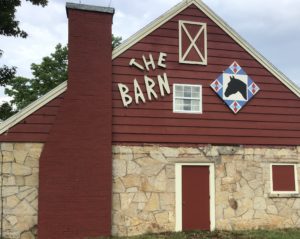
120 Shields
Holiday Island AR
#19-1, Holiday Island, is at 120 Shields, Holiday Island, AR. The Holiday Island barn was built in 1938 by Richard Shields, a Kansas City oilman, and used for Tennessee Walking horses. Although it was sold several times it continued as a horse barn until 1974 when it was converted to a steak house with live music, such as Hank Thompson. It was sold and reopened as a restaurant until 1994. It then was operated by Holiday island for various social functions. in 2008, with a contribution from the Wisconsin Club, Friends of the Barn was established to help preserve and restore it. The historic barn at Holiday Island has hosted many functions from weddings, family reunions, and birthday parties to activities sponsored by the HI Recreation Center like line dancing and yoga. Club and organization events use The Barn several times a year. The Barn is available to rent for any occasion whether you are a property owner or not. Information can be found on our website at holidayisland.us or by calling the Rec center at 479-253-9890. The artist, Denise Marta-Burch, incorporated the Arkansas star quilt pattern on the corners of the horse. Denise currently lives at Holiday Island. She is a San Francisco native and a graduate of Academy of Art in San Francisco and the Art institute of California. Denise can be reached at www.RidgelineArts.com.
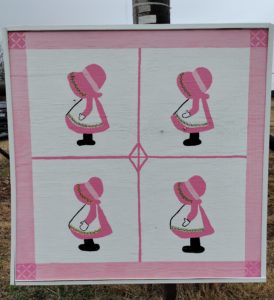
3321 AR-221
Berryville AR
#19-2, Sunbonnet Sue, is at 3321 AR-221, Berryville, AR. Miss Sunbonnet Sue began showing up in the 1900’s after the publication of Sunbonnet Sue primers in the early 20th century. Bertha Corbet and Eulalie Osgood Grover teamed up to teach children to read with illustrated anecdotes about Sunbonnet Sue, Fisherman Fred, and Suspender Sam. Teachers fell in love with these stories. Over 100 years later and the characters are still popular in quilts. This block is in honor of the Biggerstaff family who arrived in Carroll County in the early 1880’s. It was sponsored by Julie Dotson-Clark, a granddaughter of that family. It was painted by Gloria Stevens and Starlene Lee. The property is owned by Joe Pat and Angela Youngblood.
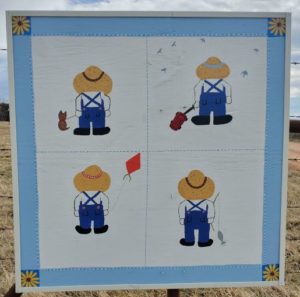
7621 AR-221
Berryville AR
#19-3, Suspender Sam, is at 7621 AR-221, Berryville. The companion design to Sunbonnet Sue, the pair became popular in the early 1900’s. This quilt block is in memory of Junior Dotson, a hard-working man and a great family man. Junior was born October 13, 1943 and died February 10, 2021. The block is sponsored by his daughter Julie Dotson-Clark and was painted by Starlene Lee and Gloria Stevens. The property is owned by Randall and Vickie Smith.
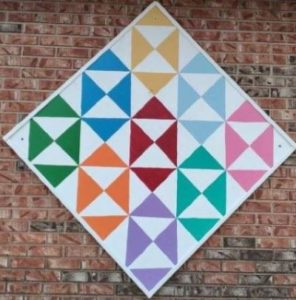
312 E. Main St.
Green Forest AR
#19-4, Broken Dishes, is at 312 E. Main St., Green Forest, AR. The block is found at Edna’s Cafe. Broken dishes is a simple pattern consisting of triangles arranged in a four-patch square. The squares are turned at different angles to give the broken dish effect. It is a popular pattern with examples dating back to the 1790’s and is one of the most common and earliest recorded design in quilt history. This quilt was also used in the underground railroad. It meant that at some point, broken crockery would point the way. The pattern has several different names: Old Tippecanoe, Hour Glass, Whirling Blade, Bow Tie, and Yankee Puzzle. The block is in honor of Donna Lee, born July 7, 1937 and died July 2, 2010. It was painted by Starlene Lee and donated by Chris and Starlene Lee.
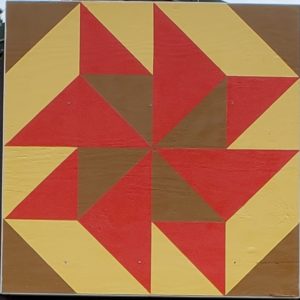
3240 CR 504
Berryville AR
#19-5, Catch Me If You Can, is at 3240 County Road 504, Berryville, AR. It’s 160 years after the Civil War and we still delight in hearing stories of the war and the freedom of the slaves. This lively quilt is in honor of that time and of the men who came back to Carroll County after serving in the war. This quilt block is in memory of the men and their families and the place they chose to settle. The quilt was painted by Karen Johnson and sponsored by Steve and Karen Johnson. Back in 1919, M.D. Anglin talked to the old-timers and wrote their story of how Pension Mountain got its name. It was published in the White River Historical Quarterly, Vol. 36, No. 3, Winter 1997. “…but the Rebels finally found a solution to this matter, and their being greater in numbers, made life so miserable for the Yankees that they all moved out south of town to a mountain now called Pension Mountain. The name was taken from the fact that all the old Yankee veterans that lived there drew a federal pension, and a pretty good wad for those times. Also, some of their descendants still live there. The Rebel[s] got a pension from the State of Arkansas, but not much. Pension Mountain is located about four miles south of Berryville. An early topography map lists the mountain as being about 2 or 3 miles wide at the top and about 6 or 8 miles in length, extending from Trigger Gap eastward to Brushy. It’s approximately 1565 feet above sea level.” The block is called “Catch Me If You Can” which was a Civil War era pattern. This pattern can be found in Barbara Brackman’s Civil War Sampler: 50 Quilt Blocks with Stories from History. This lively block is stitched of only one triangular pattern piece and captures the cleverness of the pattern colors.
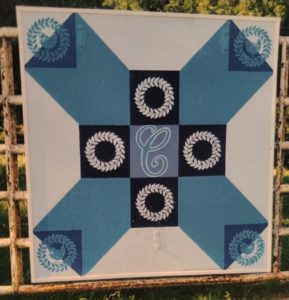
2718 AR-21 South
Berryville AR
#19-6, Farmers Daughter, is at 2718 AR-21 South, Berryville, Arkansas. The Farmers Community is located south of Berryville, on Highway 21 near Osage Greek and the historic “Glenn or “Cove” community. The Farmer’s Daughter quilt block is in honor of this community. It is made up of simple squares and triangles typically made up of three- colors. It is also known as the Corner Post, Flying birds, Miller’s Daughter, and the Rolling Star. This block was printed in the Kansas City Star in 1932. This quilt block is in honor of Laverta Allred Colvin who taught school at the Farmers community. The property is owned by the Colvin Family. The block was painted by her granddaughter Jennifer Colvin Robertson.
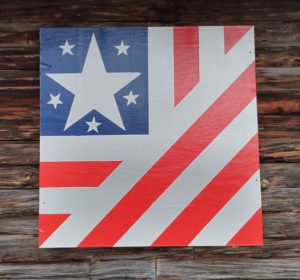
216 W. Madison Ave.
Berryville AR
#19-7, God Bless America, is at 216 W. Madison Ave., Berryville. Owner Andrea Collins relates the story. This quilt is in memory of my parents, Dwight Landes and Mary Castillo. My father served his country in the U.S. Marines, during the Korean War, from 1951 to 1954. He passed away December 10, 2014. My mother passed away July 4, 2014. In 2018, I started quilting and made my first quilt in memory of my mom and have been quilting since. My husband, Kenneth Collins, proudly served his country in the U.S. Army, during the Vietnam War, from 1966-1969. I honor him with this quilt flag. This quilt was painted by Andrea Collins. You can see this block behind the Berryville Square in the Pioneer Park hanging on the Little Jail. It faces Tabor Street.
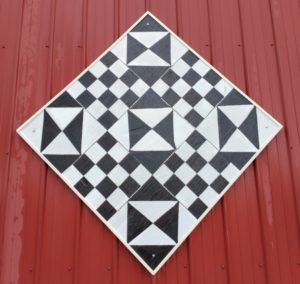
112 CR 461
Berryville AR
#19-8, Railroad Crossing, is at 112 CR 461, Berryville. The town of Urbanette was founded in 1902, the historic settlement of the Stanley family. The town was a combination of the names of two business men from Texas, Urban and Benett. The men built a store, hotel, livery stables, and a restaurant to serve the local passengers ,wheat farmers, cattlemen and railroad workers. The town was sometimes referred to as “Hump.” The name of this quilt block is “Railroad Crossing”. It represents the railroad that came through Urbanette. It is sponsored by The Carroll County Historical and Genealogical Society and was painted by Starlene Lee. The property is owned by Ronald Summers and the block is in loving memory of Kathy Summers who was born Jan 30, 1950 and died Jan 31, 2007.
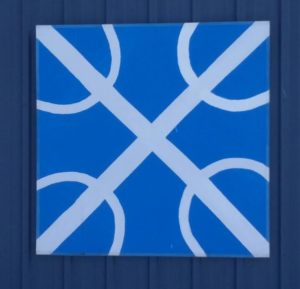
14643 AR-21
Oak Grove AR
#19-10, Crossroads, is at 14643 AR-21, Oak Grove, AR. Blue Eye is an incorporated town in Carroll County Arkansas. This border town was originally known as “Butler’s Barrens” for its level, bushy topography. The area was nearly deserted during the Civil War, due to constant border conflicts and Bushwackers. Elbert N. Butler was the first postmaster of Blue Eye. The crossroads quilt pattern is part of the underground railroad, it directed escaping slaves to travel to Cleveland, Ohio the major crossroad to Canada. One of our first settlers was a Jones. This family still lives in this area and in 1998 the family built this building. The Crossroad Quilt pattern was picked out for the “Jones Corner” area. The property is owned by Dean & Jane Jones and the block is sponsored by Dena Myers. It was painted by Starlene Lee.
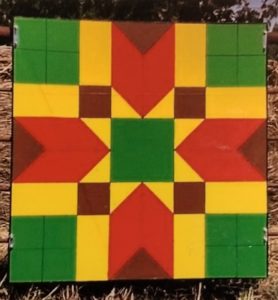
1367 CR 447
Berryville AR
#19-11, Arrow Point, is at 1367 County Road 447, Berryville, AR. This is a traditional quilt block that displays the same strength and character that the pioneers possessed in the development of this grand country. When we started clearing this land for our farm house, we stumbled across many different types of flint rock and other rock formations that would have been used by a Native American tribe. Many pieces were broken but you could see the wear on them as they had been used. Scrapers, arrow points, pestle, and others. We believe that at some point in time this property was inhabited by a Native American tribe. Arrowheads are among the most easily recognized type of artifact found in the world. Untold generations of children poking around in parks or farm fields or creek beds have discovered these rocks that have clearly been shaped by humans into pointed working tools. The reason there are so many projectile points to be found, even after centuries of determined collecting, is that the technology is a very old one: people have been making points to hunt animals for over 200,000 years. Indian camps were not placed randomly in a landscape. There were long-term occupations where people lived year-round, short term hunting camps, overnight camps spaced along a trail for travel, and gigantic camps where many tribes met once a year for trade and socializing. Each one of these camps could produce a range of artifacts that help identify the type of camp. Some campsites were so advantageous that they were occupied continuously for 10,000 years. We would bring out our oldest grandsons and they would go exploring to find these artifacts. They wrote at least three books about their adventures here on this property. The books were called “The Two Little Boys.” These were published and given out to family members. They helped build this farm. The block is dedicated to Lucas Swan and Draven Swan. The area where our house is would have been a good strategic location for a camp due to being able to watch the low land. It would also have been a good stronghold due to the “top of the mountain” location. As we have continued to clear our land to put in fences and barns (with the help of our son and his wife, Jake and Chio White, and our son and his family Dustin, Megan, Lily, Mayson and Elliana Lawrence; our grandsons Lucas and Draven Swan and the help of our neighbors Aubrey, Nicole, Tommy and Rayden Peden), we continue to find these types of artifacts. Therefore, when we decided to name our farm, we chose Arrow Point Farm, LLC.
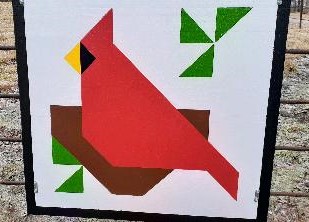
1367 CR-447
Berryville AR
#19-12, Cardinal, is at 1367 County Road 447, Berryville, AR. It is owned by Dan and Carola White. Berryville, AR. Cardinals are beautiful birds, beloved by birders and non-birders alike. However, they are more than just familiar and easily identified guests at your feeders and backyard baths. Northern cardinals are associated with a great deal of folklore, legends, and spiritual beliefs in many different culture. Coloration is not all that makes cardinals a key figure in different spiritual beliefs. It is common folklore that a visit from a cardinal represents a sign from a loved one who has passed. While this belief cannot be traced to a single origin, birds have often symbolized heavenly visitors, messengers to the gods, or even the gods themselves in feathered form. This belief has been part of ancient Egyptian, Celtic, Maori, Irish, and Hindu spiritualism, as well as the lore and legends of many Native American tribes. According to Native American culture and legends, the red cardinal has very strong ties to native ancestors and are known as the messengers of the spirits. In Native American folklore, cardinals represent loving relationships, courtship, friendship, loyalty, and devotion. Cardinals are most commonly associated with their bright red plumage and mohawk like head. This bright red coat is the first thing that people notice about the bird, giving an impression of importance and strength. This block is in remembrance of our loved ones who have gone home. Lucas Daniel White, son of Dan and Carola White B:10/24, D:10/24. John Carl Thompson, Dr. Don White, Dolores Cash White, John Elroy Mulkey, Iva Eunice Wolfe Mulkey, Opal May Hulseman, Naomi Cash Dellinger, Hank and Opal Hulseman, Siblings of John Carl Thompson, Carlos Ray Mulkey, Glen Doyle Mulkey, David Schoen, Vern and Venna Thompson, Sherman Dellinger, Roy Cash, Logan Jordan, Siblings and Brothers and Sister of John S Mulkey and Grace Parvin, Siblings and Brothers and Sisters of Benjamin F Wolfe and Talitha Graham Wolfe. And many loved ones and friends. “Cardinals are birds that mate for life and their relationship has often been a metaphor for the unconditional love that we are all searching for in a partnership. This goes beyond the love of a relationship and stretches to include the unconditional love of the universe and the Divine connection that we all have. Just as cardinals are devoted to their mate, they also show up to you again and again to teach you this power of love and devotion, and to let you know that you are not alone. This can be a deeply comforting message to those who have experienced trauma in their past, a deep rejection, or are processing grief after a separation.”
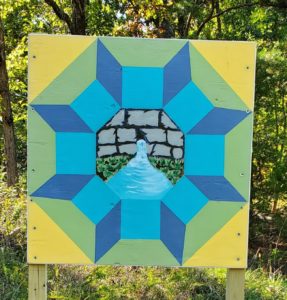
CR-523 & CR-501
Berryville AR
#19-13, Castle Wall, is at the intersection of CR-523 & CR-501, Berryville, Ark. You can see this beautiful quilt block hanging at the Historic Johnson Springs. It’s at a hiking trailhead. The block was made by Karen Johnson. After several drought years that stressed the existing water system of wells and local springs, the city of Berryville acquired the 387 acres on Pension Mountain, five miles south of the city. When purchased in February of 1933 this property surrounded the historic Johnson Spring and functions as a ‘spring preserve.’ Today this tract of land includes the Johnson Spring, the Pension Mountain Cemetery and the Pension Mountain Trails. As the Johnson Spring was 176 feet higher than the top of the city’s downtown water tower, engineers developed a plan to create a gravity fed water system, ultimately the largest such system in the mid-west. In the midst of America’s great depression, in January 1934, Mr.Jim Hyde was hired by the city’s water commissioners with funding received from the Reconstruction Finance Corporation (RFC). Mr. Hyde coordinated the local labor and resources to lay water pipe from the Johnson Spring location to the Berryville Town Square water tower (approximately 6 miles). On Saturday, June 9, 1934 at 2:22 p.m. water was added to the main and overtopped the tower tank. At that time “C.C.Whiteley, the Mayor, caused the fire alarm to sound”. Repeated measurements of the spring flow fixed it’s supply at a minimum of 60 gallons per minute and this new source was promoted as a ‘soft-water’… “not chemically treated in any way whatsoever.” So great was the enthusiasm for the Johnson Spring, they put out publicity in Berryville and surrounding towns that the new water supply had curative agencies and would help ailments of the kidneys, bladder, stomach and intestinal tract. Some went as far as to hint that the “fountain of youth “ which Ponce de Leon searched for and didn’t find…. might be the Johnson Springs. Over time, with periodic shortages of water, and an increasing need, Berryville developed several additional water sources, including Bunch Springs and the Kings River. Today, the Berryville municipal water system is treated surface water from Carroll and Boone Water District whose source is Beaver Lake.
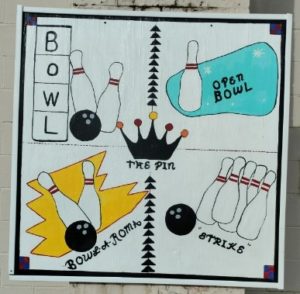
702 W. Trimble
Berryville AR
#19-14, The Pin, is at 702 W. Trimble, Berryville, Ark. Bowling is a target sport and recreational activity in which a player rolls a ball toward pins . In 1930 a British Anthropologist Sir Flinder Petrie discovered a collection of objects in a child’s grave in Egypt that appeared to him to be used for a crude form of bowling. If he is correct, then bowling traces back as far as 3200 BC. In the 15th -17th centuries lawn bowling spread from Germany into Austria, Switzerland, and the low countries. Balls were made using the husk of grains in material such as leather and bound with string. On January 1840, Knickerbocker Alleys in New York City opened, becoming the first indoor bowling alley. In 1875 ,The National Bowling Association (NBA) was founded by 27 local clubs in New York City to standardize rules for ten -pin and setting the ball size and the distance between the foul line and the pins, but failing to agree on other rules. It was superseded in 1895 by the American Bowling Congress. This quilt is in honor of a very old sport and can be seen on the building of the “The Pin” in Berryville at 702 W. Trimble Ave. It was sponsored by the owner Rusty Dycus and was painted and designed by Starlene Lee & Gloria Stevens. Come by and play one of the oldest target sports games in history.
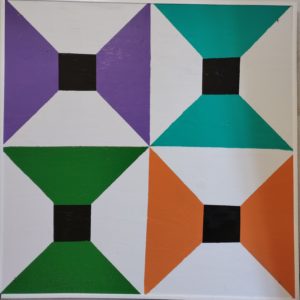
14493 US 62 E.
Alpena AR
#19-15, Bowtie, is at 14493 US 62 E. Alpena, Ark. The town of Alpena is located in both Boone and Carroll counties. Alpena Pass was founded in 1908 on top of a graveyard, shortly after the Missouri and North Arkansas Railroad was built through Boone County. In the 1950’s the pass was dropped from the name. At the time of the town’s founding, the town of Carrollton was in decline. Many of the buildings from Carrollton were disassembled and reassembled at Alpena Pass. Alpena’s population was 392 in 2010 . The Bowtie quilt is one of the signals from the underground railroad. It told slaves to dress in better clothing and disguises so they would not stand out. This Bowtie is sponsored by Dena Myers. The quilt block was painted by Starlene Lee. The property is owned by Mike A. Forney and Alpena Monument Works.
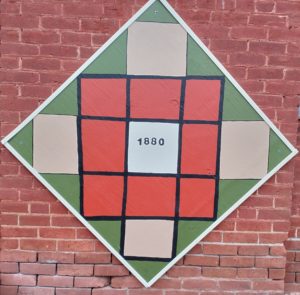
403 Public Square
Berryville AR
#19-16, Courthouse, is at 403 Public Square, Berryville, Ark. The Carroll County Courthouse, Eastern Districts, is one of two county seats serving Carroll County. The historic courthouse on the Public Square in the center of Berryville was built in 1880 and repeatedly enlarged to a three-story structure. It now houses the Heritage Museum and the Carroll County Historical Society. It was listed on the National Register in 1976. The block is owned by Carroll County and is sponsored by the Historical Society. It was hand painted by Starlene Lee.
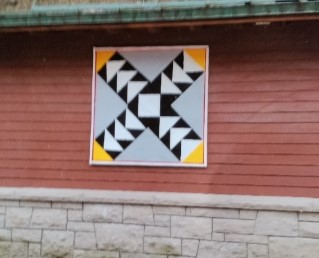
299 N. Main St.
Eureka Springs AR
#19-17, Railroad Crossing II is at 299 N. Main Street, Eureka Springs, Arkansas. This pattern has a long and storied history. According to Barbara Brackham of Civil War Quilts, the name comes as a reference to the first battle of the Civil War, during which Confederate soldiers destroyed the railroad tracks at Manassas Junction in Virginia in an attempt to sabotage the Union Army. During the early summer of 1861,Confederate recruits gathered in Prince William County Virginia, at the crossing of two railroads, the Manassas Gap and the Orange at Alexandria. By July, 20,000 Southerners were waiting for the first great battle of the Civil War as 35,000 troops in the Union Army left Washington City to march to Richmond, the Confederate capital. Union General Irvin McDowell’s first goal was to capture the railroad crossing that led to Richmond. Excited Washingtonians followed the federal army, carrying picnic baskets for a summer outing while they watched Union Troops vanquish the Rebels and put a short end to the war. On July 18th they met General Pierre Beauregard’s army at a creek named Bull Run about 25 miles from Washington. Over the next few days rebel troops ,backed up by 10,000 reinforcements held their ground. The novice Federal soldiers fled in chaos, running panicked spectators off the roads back to the Union capital. Over 400 Union troops were killed and nearly that many Confederates. With this the North and the South were jolted into realization that this was not a 30-day war. This Quilt Block Railroad Crossing II commemorates the first battle called by the Confederacy. You can see this quilt in Eureka Springs at the Music park near the train depot. The Eureka Springs & North Arkansas Railway is a for-profit passenger tourist railway established by the late Robert Dortch Jr. and wife Jane in 1981. It operates along a 2.5-mile ride. This quilt block is sponsored by a resident of Eureka Springs and was painted by Starlene Lee.
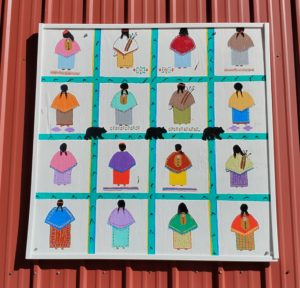
65 Stadium Rd.
Eureka Springs AR
#19-18, Osage Women, is at 65 Stadium Road, Eureka Springs, Ark. “Oh-sa-je Wako.” This Quilt is in honor of the Osage Indians in Carroll County .The Osage Indians had lands in Arkansas and Missouri. The land was taken from them by the U.S. government in 1808 and 1818, and in 1825 an Osage Reservation was established in Southeastern Kansas. Carroll County had several places that the Osage settled. One area was in Eureka Springs on the White River. The Osage called themselves (Oh-sa-je) the “Little ones” and Ni-u-kon`-ska” or Children of the Middle Waters”–Wako means women. Quilting was introduced to Native Americans by missionaries ,who thought to “civilize” the Natives by teaching them traditional homemaking skills. The Natives incorporated their own designs, trying to keep alive their heritage. This quilt was sponsored by Butch Berry. It was painted by Starlene Lee and the building on which it hangs is a part of Eureka Springs history. The building, constructed in 1945, is known as the “Old Sale Barn.” The Barn is now an antique store operated by Jay and Nancy Bullock.
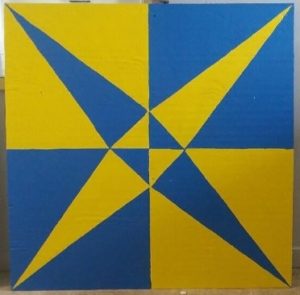
374 Dairy Hollow Rd.
Eureka Springs AR
#19-19, Canoe, is at 374 Dairy Hollow Rd., Eureka Springs, Arkansas. The Canoe quilt block represents one of the underground railroad signals. It told runaway slaves to look for canoes to help them cross rivers and waterways. This quilt is sponsored by S. Williams and was painted by Starlene Myers Lee. The property is owned by Clear Springs School. The school was founded by Will and Laurie Fulton and Molly Fulton Seeligson. The school was founded in 1974. The schools began in a one room building over the years and has been moved to four different spaces including the historic “Old Red Brick School” (later destroyed by fire in 1990). With its growth the school acquired 16 wooded acres and now it has buildings with classrooms and administrative offices near the “Dairy Hallows.” The Dairy Hallows is a Writers Colony of all genres, including culinary, composers, and artists without discriminations. The Dairy Hollow is located in historic arts village Eureka Springs, Arkansas in the Northwest corner of the Ozark Mountains. Find out more by looking at the CALS encyclopedia of Arkansas.
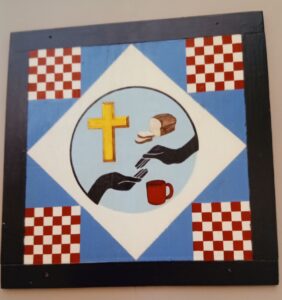
28 Flint St.
Eureka Springs AR
#19-20, Fellowship, is found at 28 Flint St., Eureka Springs. The Little Chapel, built in 1880, was a house of worship for many years. Later on, the building adjacent to the stagecoach shop was a feed store and then a grocery store. Since 1991, Flint Street Fellowship has served the needs of Eureka Springs and Carroll County residents west of the Kings River. A 501 (c) nonprofit charitable organization, services have expanded across the years to meet the needs of the community. Flint Street Fellowship is entirely volunteer based. It serves as a food pantry, provides clothing, Back our Kids program, and the Pat Kasner Angel Assistance Fund. Sometimes Thanksgiving and Christmas Dinners are held at ECHO. Flint Street Fellowship was founded as a faith-based ministry and that mission continues to this day. Our organization is supported through local churches, businesses, grants, fundraisers, and individuals who believe in serving the needs of others. The barn quilt was designed, painted, and constructed by Sharon and Miles Shultz, Nancy Bennett, and Robin Makidon.
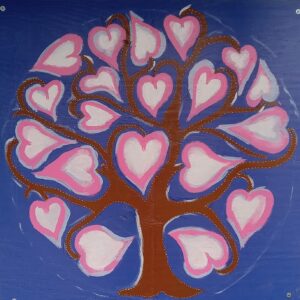
4127 E. Van Buren
Eureka Springs AR
#19-21, Tree of Life, is at 4127 E. Van Buren, Eureka Springs. Eureka Springs was founded in 1879 when people flocked there for the healing springs of the area. The earliest dated tombstone in the cemetery is July 14, 1880. More than likely there were burials prior to that date as there are hundreds of unmarked graves throughout the cemetery. It was established in 1889 when the Independent Order of Odd Fellows, a benevolent organization, bought 46.5 acres for the cemetery. Families of those buried here, still come to visit the resting place of their ancestors. The Eureka Springs City Cemetery was placed on the National Register of Historic Places in May 2018 under the National Park Service. Gloria Stevens chose the Tree of Life to represent the Eureka Springs Cemetery. The leaves are represented as hearts. “Even though our loved ones have passed through the gates of death, our hearts are forever entwined.” This quilt block is designed and sponsored by Gloria Stevens. It was painted by Chris and Starlene Lee and Gloria Stevens.
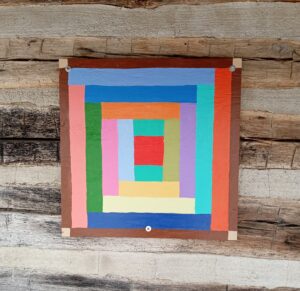
216 W. Madison St.
Berryville AR
#19-22, Log Cabin, is at 216 W. Madison Street in Berryville, AR. The Log Cabin quilt is one of the oldest types of patchwork. It originated in the mid-1800’s and was frequently made from scraps. The first square piece is traditionally red signifying the fireplace or chimney of the cabin. The “fabric logs”are cut from the half-light and half-dark fabric. The light fabric represents the glow from the fireplace and the dark from the shadows. Depending on the arrangement of the blocks, it may be called “Straight Furrows” as it looks like crop rows. You can see this quilt block at the Pioneer Park behind the Berryville Square. It hangs on the little log cabin belonging to the Carroll County Historical Society. This cabin belonged to the Montgomery Newberry family and was built before the Civil War, and was located in the Hopewell community in Newton County. It was moved to Berryville and reconstructed in 1978. This quilt was painted by Starlene Lee.
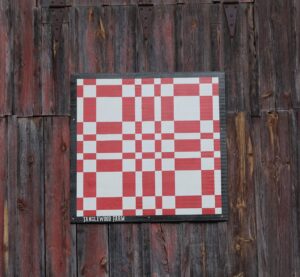
492 County Rd. 638
Green Forest AR
#19-23, The Ellis Quilt, is at 492 County Rd 638, Green Forest, AR. It hangs on Joe Hale’s barn. This barn quilt is based on a coverlet made by Nancy Jane Hilton Ellis (b.1846-d.1925) She raised the sheep, sheared the sheep, and she carded the wool and spun the thread. This coverlet quilt has a geographic pattern and uses an overshot design. What is an overshot design? Overshot is a weave structure consisting of two types of weft and floats to create a pattern. Nancy’s daughter-in-law Mena Mae Hilton-Ellis, helped her to make the coverlet /quilt. It was done about 1909, around the time that Joe Hale’s mother was born. Joe Hale is the owner of the antique quilt. Years later Joe’s grandmother, Mena gave the quilt to her other grandson, Jerry Aday, to use as a saddle blanket. Mena said “you never use anything new, if you can use something not utilized, to make a new use.” Years later when Jerry Aday was moving and found his old saddle blanket and gave it to his Uncle Joe Hale who is the collector of his family. The quilt design is just a small piece of the original coverlet design. One of Joe’s family, Cathy Valdez helped Joe paint and design the quilt hanging on Joe and Sonja Hale’s Barn.
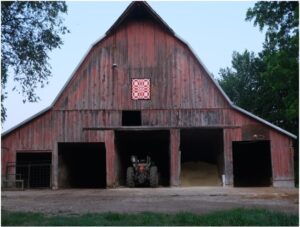
This barn is over 100 years old and located on the old Allen Holler place in Carroll County. Joe and Sonja bought it in the winter of 1959-60. It is a 281 acre farm with a 2-story house, built in 1919-1920 by Luther Shipman, with two barns on either side of the house. The farm had a smokehouse cellar, hen house, and brooder house. The 2-story house needed remodeling as no one had lived there in a long time. Mr. Shipman borrowed $500 from Joe’s grandfather, Jim Hale, to build this house. The carpenters that built the house said Mr. Shipman would work all week on the house and go home on the weekends. Some people would say that the barn, with the quilt on it was built before the house. The barn faces east and had a center hallway with two big sliding doors on the front and back sides. On the north side of the hall was a stairway to the loft and a corn crib ,and a harness room. On the south side were horse stalls and stanchions for milking the cows. On some of these boards were found poems from the Shipman daughters. Wish we had the poems today. On the south side was a shed added to the barn for calves. Another barn was built on the south side when the Anderson family owned the farm. You can still see this farm house and the huge barn today as a part of Carroll County’s history. This quilt was painted by Cathy Valdez and designed by Joe Hale and his great grandmother, Nancy Jane.
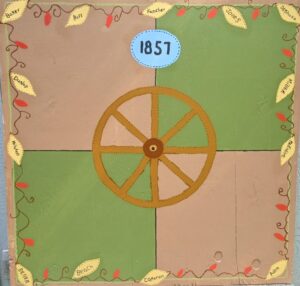
412 CR 917
Alpena AR
#19-24, Wagon Wheel is at 412 CR 917, Alpena, Arkansas. It’s located in the community of Carrollton which was once a thriving community with a population near the 10,000 mark in the 1850’s with a historically significant past. The Wagon Wheel quilt block represents families from Carroll County who were heading to greener pastures. The wagon wheel represents the wagons, the yellow leaves are the families, and the little red leaves represent the children from the train that were returned to Carroll County in 1859. The Mountain Meadows descendants wanted to place a quilt on the Arkansas Quilt Trail to tell the story of the Mountain Meadows Massacre of 1857. This quilt block represents 40+ families, from Northwestern Arkansas who left from Beller Springs, just South of Harrison, Arkansas in April of 1857. On their journey to a better life in California, they journeyed through Carrollton (then the county seat). In September of that year, they were camped in a beautiful valley called Mountain Meadows, located in Southwestern Utah where they were attacked by Paiute Indians and Mormons . At least 120 men, women and children were murdered. Seventeen of the smallest children were returned by the U.S Army in 1859. The Army was sent to retrieve them from the Mormon homes they were living in and returned them to their families in Carroll County. The surviving children were brought back to Carrollton where the Carroll County Courthouse was located, just a few yards east of this quilt block. The massacre/burial site in Utah is now a National Historical Monument. See mmm1857.org for more information on this tragic history. This quilt was designed and painted by Starlene Lee and Patty Norris. Patty is a direct descendant of the Fancher family who were part of the wagon train.
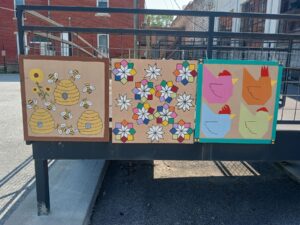
403 Public Square
Berryville AR
#19-25, Trio, is at 403 Public Square, Berryville AR. The trio of quilt blocks hangs at the back of the Heritage Museum which is housed in the old 1880 court house. Be sure to visit the museum and enjoy the exhibits including antiques, old documents, etc. on all three floors of the old structure.
Honeybee’s and Hives is salute to our honeybees (tribe Apini) and their production of one of nature’s best sweets. Honey collection is an ancient activity, long preceding the bee’s domestication. The first written word on beekeeping was in ancient Egypt.
Tumbling Blocks. The tumbling block quilt pattern is a unique 3D design that one wouldn’t think would have been popular in the 19th century, but it was. We can’t say for sure when this design was created, but we know it was introduced as early as 1851, and was in the Godey’s Lady’s book. Sometimes it was referred to as “cube work.” Before people used this design for a quilt, it was prominent in tile work and mosaics dating back to ancient Greece. The tumbling block was also used in the underground railroad. The underground railroad was a resistance effort in the 1800’s to help enslaved African Americans who wanted their freedom. People in the resistance hung quilts on fences or clothes lines, so that people trying to escape would know what to look for. They looked at the patterns. The tumbling block means ”Pack your bag and get ready to move.”
Hens and Roosters. We love our chickens and roosters. They provide us humans with companionship, food and fiber in the form of eggs, meat and feathers. Many people love to raise and show chicken and roosters at county fairs and other special shows. Others just love to raise them for pets in their backyards and for the fresh eggs that they get every day. The three quilt blocks were painted by Starlene Lee.
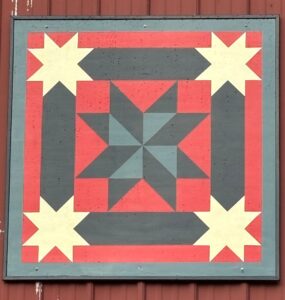
1148 CR 822
Green Forest AR
#19-26, Honor quilt block is at the property of Charles Bell at 1148 CR 822, Green Forest. The Pinwheel Star quilt block pattern is the center of this block. The Pinwheel Star became popular in the early 1800’s. It’s pattern reflecting the east to west path of the sun across the sky. It is thought it was designed in commemoration of when men where away (across the sky) fighting the war. It is framed by four sawtooth stars and painted in patriotic colors of red, white, and shades of blue in honor of the family’s military service including:
Private George W. Bell who served in the Civil War in Company E, 120th Illinois Infantry from August 16, 1862 to September 10, 1865. After serving he returned to Arkansas to own and operate a small supply store in Metalton and Bell Freight Lines, which carried goods from St. Louis and back to Arkansas by horse drawn iron wheeled Springfield wagons. He is buried at Yocum Cemetery on CR 625.
Senior Master Sergeant Lenard Charles Bell who served in the Air Force from December 2, 1960 to June 30, 1981. His overseas tours included Thailand, where he was awarded a Bronze Star for his work in Laos, and also served a tour in Korea. After retiring to the family farm in Carroll County, he worked at the Berryville Post Office from July 1982 to July 2002 and has been farming at the present property since 1989.
Senior Master Sergeant Lenard Keith Bell also served in the Air Force from October 7, 1984 to March 31, 2011. His overseas service included two tours in Germany, two tours in Turkey, and in the United Arab Emirates. Keith retired to Oklahoma City and continues to work in the Civil Service at Tinker AFB.
Machinist Mate 2nd Class Jerad James Tittel served from October 7 1990 to August 29, 1997 in the Navy on the USS Sacramento. His overseas service included the Persian Gulf. After fulfilling his duty out of Bremerton, Washington, he settled near Patton, Missouri and works at T.G., a Toyota subsidiary.
Staff Sergeant Lina Beulah Bell served in the Air Force from May 3, 2016 to May 2, 2022. Her overseas tours included Crete and Germany. Lina is presently in the Civil Service working at Eglin AFB, Florida.